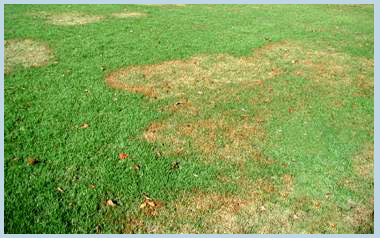Brown Patch Fungus (photo)
Ugghh, is it hot. And miserable. And right about now, your lawn is probably fairly stressed from the heat and humidity. If your lawn is anything like mine, then the weeds have taken over, and unsightly brown spots have sprouted up everywhere. But are those brown patches due to lack of water and heat, or something else? Here's a few tips that will help you decide, and how to proceed.
For those with fescue grass, now is the time to treat and prevent brown patch which appears as a browning area in the lawn typically in the summer months when conditions are favorable. Warm-season grasses (St. Augustinegrass, zoysiagrass, bermudagrass and centipedegrass) most commonly are affected by brown patch during the early spring and late fall. Brown patch is caused by a fungus, and if your lawn is showing signs, you will need to treat with a fungicide. We recommend that you apply Hi-Yield Lawn Fungicide to prevent brown patch. Two applications may be necessary if rain has been heavy.
Brown Patch Fungus(photo)
While brown patch does cause patches of dead grass, other things can cause the same symptoms. If the area is poorly drained and water stands on a spot for more than 24 hours, the grass roots will rot, causing a dead patch. Also, in areas where the sod has rooted poorly, brown patches will develop as dry weather sets in. So what are the true symptoms of the disease? True brown patch spots are small to begin with but in warm weather they can enlarge rapidly. Seen from above, the patch will look like a doughnut – a ring of tan grass having a patch of green grass in the center. Individual grass blades will be brown down to the crown – where the blade emerges from the ground – but the crown will be green. Early in the morning during hot, damp weather you might see a white fungal web at the edge of the dead grass patch.
Never water in the evening. The best time to water is in early morning. Fescue is much more susceptible when it has lush, green growth plus warm nighttime temperatures. The second step is to water at the right time. Since brown patch needs 14-16 hours of wet leaf surface to reproduce itself, water only after the dew has dried in the morning. An alternative is to water after nightfall. Since the grass is wet with dew anyway, watering in the dark does not unnecessarily extend the wet period.
So what if you have brown areas in your sod or planting beds due to poor rooting mixed with our hot summer temperatures? We have help for that, too. Garden Supply owner, Keith Ramsey, recommends treating with Drought Defense by Soil Logic to reduce water consumption and enhance growth.
Drought Defense reduces the amount of water needed to irrigate lawns, groundcovers, trees, and other plants. This soil moisture management product helps prevent plant-available water from evaporating or draining past the root zone. It is super-concentrated, long-lasting, helps lower watering bills and is safe for use on fruit and vegetable plants. Drought Defense is environmentally friendly and is safe for use around children and pets.
This easy-to-use concentrate is ready to go. Simply connect the sprayer to your hose and spray evenly over measured area. Be sure to irrigate all treated areas after application to wash the product into the soil. After two applications of the product, normal watering time and quantity can be reduced up to 50%!
Hope these tips help with your lawn care during these hot summer days. As always, our helpful experts are on hand seven days a week to answer all your lawn care and gardening questions.



